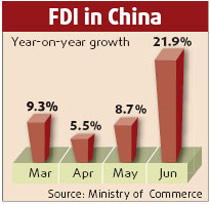Qi Jingmei
As the national economy continued its brisk momentum through the early part of the year, members of the public, administrative circles and academia began to wonder whether the growth could be sustained.
A detailed analysis of the economic situation suggests the sustainability of the growth depends heavily on how the authorities address several key problems with their macro control policies.
The current fundamentals are strong enough to back further growth, but the country also faces potential limits from resource and environmental pressure.
In 2006, the major economic indicators met expectations and even went beyond the predicted growth rate. But the country missed its target of reducing energy consumption for every unit of gross domestic product (GDP) by 4 percent.
In the first six months of this year, the six most energy-intensive industries - crude oil refining, nonferrous metal smelting, chemical engineering, electricity generation, coke production and nonmetal ore refining - saw their total industrial value added increase by 20.1 percent, which was 3.6 percentage points more than during the same time last year. The rate of energy consumption also grew quickly. The amount of electricity used by heavy industry jumped by 18.8 percent in the first half, 4.6 percentage points more than during the same period in 2006.
If this momentum is not checked in time, it will be more difficult to reduce energy consumption this year. It might also complicate efforts to cut energy consumption per unit of GDP by 20 percent and reduce pollutant discharges by 10 percent during the period of 2006 to 2010, which are goals outlined in the 11th Five-Year Plan.
So instead of being overwhelmed by the amazing economic growth, the authorities should pay more attention to reducing energy consumption and cutting pollutants.
On the one hand, the authorities should upgrade the industrial structure by promoting new technology and new materials and importing low energy-consuming technologies and equipment. Industry should consider reducing pollution its first priority.
On the other hand, the growth of manufacturing sectors that could be considered energy guzzlers should be slowed, while the tertiary sector should be boosted.
Compared with agriculture and industry, the tertiary sector consumes fewer resources and emits less pollution. Tertiary businesses put less of a burden on the environment, so expanding the sector will make our economic growth more sustainable.
In 2006, Beijing cut its energy consumption for per unit of GDP by 5.25 percent, the only provincial body to hit the 4 percent target. This success should be attributed to the relatively small proportion of the local economy occupied by heavy industry - the tertiary sector contributes more than 70 percent to Beijing's economic output.
The economies of the most energy-hungry provinces - Qinghai Province and the Ningxia Hui Autonomous Region, for example - are dominated by heavy industry.
Another important goal of the country's macro control efforts is to rein in real estate investment to maintain prices at a reasonable level. But this target is far from being achieved.
In the first six months of this year, investors poured 988.7 billion yuan ($130.1 billion) into real estate development, representing 28.5 percent year-on-year growth. The average price of property in 70 cities across the country climbed by 7.1 percent in June alone, 0.7 percentage points more than the preceding month and a record rise for the past 23 months.
Policies aimed at checking the frenzy in the real estate market are mostly focused on containing demand. Developers face stricter regulations when borrowing, down-payments for houses bought with mortgages have been increased and regulations on the purchase of multiple apartments have been put in place. However, instead of curbing prices, these policies only sped up the growth.
So policymakers should try to tackle the problem from another front: offer more supply to the real estate market.
Real estate prices in Qinhuangdao, a medium-sized coastal city in North China's Hebei Province, soared last year. The average price leapt by 11.8 percent in December 2006, making headlines across the country. But this momentum quickly ceased after the local government approved 15 estate projects within a short time. Prices soon resumed a more normal growth rate.
Another factor pushing up real estate prices is that many developers hoard land or houses in the hopes of selling them in the future at higher prices. Hoarding exacerbates the shortage of supply and supports price rises.
When the real estate market has abundant supply, prices rise more slowly. An increased supply should include multiple types of residence: market rate homes, government-subsided low-priced homes and low-rent homes. Thus, the demands of different social groups will be satisfied in different ways, and the real estate market will see a balance between demand and supply.
Since the start of the new year, the central government has launched several measures to help the economy develop more smoothly, but few of them delivered as much as expected.
A key reason is that the market is playing a more important role in the economy. The market has its own rules to balance demand and supply, to guide the flow of resources and to ensure competition among players.
The development of the past few decades has left China's market relatively mature, and its performance in the areas mentioned above is much stronger than in the past.
Macro control policies should only be aimed at settling issues that the market cannot settle, or at maintaining the market order.
Policymakers should try to improve the economy's structure with monetary and fiscal policy, rather than paying overt attention to the details of the market.
The author is an economist with the State Information Center
(China Daily September 24, 2007)


